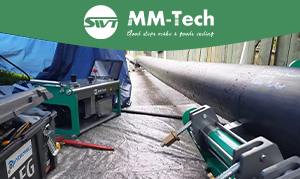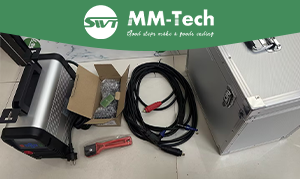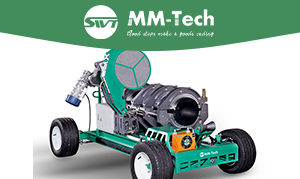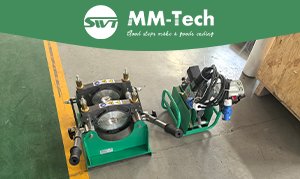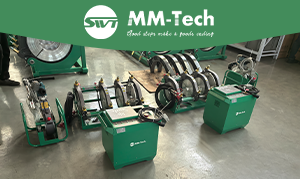Poly welding, also known as pipe fusion, is a method used to join plastic pipes. This process involves heating the pipe ends and pressing them together, resulting in a durable, leak-free connection that stands the test of time.
A pipe fusion welder is essential for industries such as water systems, gas lines, and plumbing. This technique is highly valued because it creates reliable and robust pipes for large-scale projects. Globally, the adoption of pipe fusion is on the rise as it saves time, supports environmental sustainability, and contributes to future-ready infrastructure. For instance:
Pipe fusion welders and plastic welding tools are utilized in industries like automotive, electronics, and aerospace.
Rapidly expanding industries in the Asia-Pacific region are increasingly relying on pipe fusion technology.
Companies are opting for eco-friendly materials and methods, like pipe fusion, to align with global sustainability goals.
Whether for residential plumbing or major industrial projects, poly welding with a pipe fusion welder offers strength, flexibility, and long-lasting results.
Key Takeaways
Poly welding, also called pipe fusion, joins plastic pipes tightly.
It uses heat and pressure to make strong, leak-free connections.
There are three main methods: butt fusion, electrofusion, and socket fusion.
These methods work for different pipe sizes and uses.
Poly welding saves money and time by skipping glue or gaskets.
It is eco-friendly because it uses recyclable materials and cuts waste.
This makes it a good choice for building projects.
Learning how to do poly welding is very important.
Training helps people use welding tools safely and correctly.
What is Poly Welding?
Definition and Overview
Poly welding, or pipe fusion, joins plastic pipes using heat and pressure. This method bonds pipe ends together, creating a strong, leak-proof connection. It is often used with HDPE pipes, which are popular in many industries.
Special tools, like a pipe fusion welder, heat the pipe ends until they melt. The melted ends are then pressed together and cooled to form one solid piece. This process makes the joint as strong as the original pipe, perfect for tough and reliable applications.
Poly welding doesn’t need glue or screws, making it cleaner and easier. Whether for small plumbing jobs or big industrial projects, this method provides a strong and lasting solution.
Importance in Industrial Applications
Poly welding is important for industries needing strong, long-lasting pipes. For example, water systems use it to make leak-free pipes that handle high pressure. Gas pipelines also rely on it for safe, secure joints that prevent leaks.
In mining, HDPE pipes carry rough materials, and welded joints handle the tough conditions. In farming, this method builds irrigation systems that are durable and efficient.
Poly welding is also good for the environment. It uses recyclable materials, cutting waste and helping sustainability. By using this method, you help create strong, eco-friendly infrastructure.
Main Techniques of Poly Welding
Poly welding uses different methods for various pipes and jobs. Knowing these methods helps you pick the best one for your needs. Here are three main techniques used in poly welding.
Butt Fusion Welding
Butt fusion welding is a common way to join HDPE pipes. It heats two pipe ends until soft, then presses them together. This creates a strong joint, as tough as the original pipe. It works well for high-pressure systems.
Modern machines make this process faster and better. Some machines have dataloggers that track the welding process. This helps ensure the weld is done correctly. Studies show improved welding steps can make joints stronger and less likely to crack.
Important factors for butt fusion welding include:
Butt Fusion Pressure: Usually between 30 and 90 psi, based on pipe size.
Heating Plate Temperature: Kept at 400°F to 450°F for proper melting.
Cooling Time: Depends on pipe size and ensures the joint is stable.
This method is widely used for water pipes, gas lines, and industrial systems. Its strong, leak-proof joints make it a key technique for HDPE pipes.
Electrofusion Welding
Electrofusion welding is another way to join HDPE pipes. It uses special fittings with built-in heaters. When powered, the heaters melt the pipe and fitting, creating a strong bond.
This method is great for tight spaces or joining different pipe sizes. Tests show its reliability:
Test Type | What It Shows | Result |
|---|---|---|
Squeeze Test | Joints stayed strong even after squeezing. | Passed |
Fatigue Loading | Joints lasted 170 hours under stress. | Very reliable |
Flexibility | Works with many types of polyethylene pipes. | Very versatile |
Electrofusion welding is often used for gas lines, water systems, and repairs. Its strong and steady joints make it an important method for HDPE pipes.
Socket Fusion Welding
Socket fusion welding is simpler and used for smaller pipes. It heats the pipe end and fitting separately. Then, the pipe is pushed into the fitting, and they cool together to form a bond.
This method is good for jobs needing precision and ease. It’s often used in plumbing, irrigation, and low-pressure systems. Socket fusion welding is a cheaper option for projects not needing high-pressure strength.
Though less flexible than other methods, it’s still reliable for certain tasks. Its simplicity makes it a useful choice for HDPE pipe welding.
Step-by-Step Guide to Pipe Fusion Techniques
Butt Fusion Process for HDPE Pipe Welding
The butt fusion method is a trusted way to join HDPE pipes. It makes a joint as strong as the original pipe. Follow these simple steps for the best results:
Preparation: Place the pipes in the fusion machine. Clamp them tightly to stop movement. A steady setup helps make a good weld.
Heating: Heat the hot plate to 350°F. Press the pipe ends onto the plate evenly. Keep the temperature between 400°F and 450°F based on pipe size.
Shaving: Use a tool to shave the pipe ends flat. This removes bumps and makes the surface ready for welding.
Fusion: Take off the hot plate and press the melted ends together. Apply steady pressure to form a strong bond.
Cooling: Hold the pressure until the joint cools and hardens. This step keeps the weld strong and solid.
Inspection: Look at the joint closely for any problems. If needed, test the weld to check its strength.
This process works well for water pipes and gas lines. Following these steps ensures a tough, leak-free connection.
Electrofusion Process for HDPE Pipe Fusion
Electrofusion uses special fittings with heaters inside. It’s great for tight spaces or joining pipes of different sizes. Here’s how to do it:
Preparation: Clean the pipe ends and fitting inside. Dirt can weaken the weld.
Alignment: Put the pipe ends into the fitting. Make sure they line up correctly. Misaligned pipes can cause weak joints.
Heating: Attach the fitting to an electrofusion control box. The heaters melt the pipe and fitting surfaces.
Fusion: Let the melted parts bond together. The control box sets the heating time and temperature.
Cooling: Let the joint cool without moving the pipes. This keeps the weld strong.
Inspection: Check the joint for visible flaws. Test it if needed to ensure safety.
This method is often used for gas pipes and water systems. Its accuracy makes it a popular choice.
Socket Fusion Process for Pipe Fusion
Socket fusion is a simple way to join smaller pipes and fittings. It’s used for plumbing, irrigation, and low-pressure systems. Follow these steps:
Preparation: Clean the pipe end and fitting. Dirt can stop the bond from forming.
Heating: Heat the pipe end and fitting separately with a socket fusion tool. Make sure both parts melt properly.
Insertion: Push the heated pipe end into the fitting. Hold them together until they stick.
Cooling: Let the joint cool naturally. Don’t move or press the parts during this time.
Inspection: Check the joint for gaps or uneven spots.
This method is affordable and easy to use. It’s a good option for small projects.
Equipment Needed for HDPE Pipe Welding
Pipe Fusion Welder and Its Importance
A pipe fusion welder is key for welding HDPE pipes. It uses heat and pressure to make strong, leak-free joints. Different types of welders are used for specific jobs. For example:
Butt Fusion Machines: These are best for big pipes, like those over 24 inches wide. You can change the heat and pressure settings for accurate welding.
Electrofusion Machines: These work well for smaller pipes, up to 12 inches wide. They control voltage and heating cycles to keep joints strong.
Saddle Fusion Machines: Use these for branch connections. They let you adjust pressure and heating time based on pipe size.
Modern welders often have smart features like automation and IoT. These make welding faster and more accurate. Whether fixing pipes in tight spaces or building networks, the right welder helps your project succeed.
Extra Tools for HDPE Pipe Welding
Besides the pipe fusion welder, other tools are needed for welding HDPE pipes. These tools prepare pipes and fittings for a smooth process. Important tools include:
Pipe Cutters: Cut pipe ends neatly for better welding.
Scrapers: Remove the top layer of the pipe for a strong bond.
Alignment Clamps: Hold pipes steady during welding for a solid joint.
Heating Tools: Melt pipe ends and fittings evenly for socket fusion.
Using the right tools makes welding easier and better. For example, clamps keep pipes steady, while scrapers clean surfaces for bonding. High-quality tools help you get great results in your welding projects.
Advantages of Poly Welding
Strong and Durable HDPE Pipe Joints
Poly welding makes joints as strong as the pipe itself. This strength comes from melting and bonding the pipe ends together. Unlike glue or fittings, it creates a leak-proof connection. HDPE pipes, known for being tough and flexible, work well with this method. These welded joints can handle high pressure and tough conditions without breaking.
For example, in water systems, welded HDPE pipes don’t crack easily. They also handle temperature changes without problems. This strength means less fixing and longer-lasting pipes. Using poly welding helps build reliable and durable piping systems.
Saving Money with Pipe Fusion
Poly welding saves money compared to older welding methods. It doesn’t need glue, gaskets, or extra materials, cutting costs. The process can also be automated, saving time and reducing labor costs.
Here’s how poly welding compares to other methods:
Feature | Friction Stir Welding (FSW) | Traditional Welding Methods |
|---|---|---|
Type of Process | Solid-state | Fusion |
Automation Level | High | Low |
Extra Materials Needed | None | Yes |
Speed of Work | High | Varies |
Cost Savings | Big | Moderate |
Choosing pipe fusion saves money and gives great results. It’s perfect for big projects and long-term use.
Works in Many Situations
Poly welding is useful for many jobs and industries. It works for water systems, gas lines, mining, and farming. You can join pipes of different sizes and shapes, even in hard-to-reach places.
For example, in gas pipelines, poly welding makes safe, leak-proof joints. In farming, it builds irrigation systems that last a long time. Whether for home plumbing or big industrial projects, this method offers strong and flexible solutions.
Poly welding’s ability to handle different needs makes it a top choice. It’s reliable for all kinds of piping projects.
Poly welding is a strong way to join HDPE pipes. It uses heat and pressure to make leak-free connections. These connections are tough and last a long time. This method is important for water systems, gas lines, and farming.
There are three main techniques: butt fusion, electrofusion, and socket fusion. Butt fusion is great for high-pressure pipes. Electrofusion works well in small spaces. Socket fusion is best for smaller pipes and fittings.
For strong and affordable pipe systems, try poly welding. It gives durable, flexible, and long-lasting results for HDPE projects.
FAQ
What’s the difference between butt fusion and electrofusion?
Butt fusion heats and presses pipe ends to join them. Electrofusion uses fittings with heaters to bond pipe ends. Butt fusion is best for big pipes. Electrofusion works well in tight spaces or with different pipe sizes.
Can poly welding work for all pipe types?
No, poly welding is only for plastic pipes like HDPE. It doesn’t work on metal or other materials. Always check the pipe type before welding to ensure it works.
How long does a welded joint last?
A good welded joint lasts as long as the pipe. This can be over 50 years. The joint’s life depends on the method, pipe type, and conditions. Regular checks keep the joint strong.
Is poly welding good for the environment?
Yes, poly welding is eco-friendly. It uses recyclable materials and skips glue or chemicals. This lowers waste and helps the planet. It’s a smart choice for green projects.
Do you need training for pipe fusion?
Yes, training is needed for pipe fusion. It teaches you how to use tools and stay safe. Many groups offer classes to help you learn welding skills.


